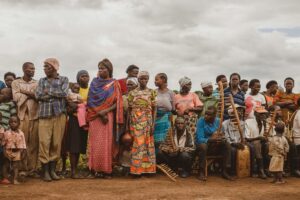Celebrating Uganda’s Cultural Diversity Through Safaris
Introduction
 Uganda culture is a vibrant tapestry of traditions, languages, and customs shaped by over 360 diverse tribes. This article explores Uganda’s rich heritage, from its music and dance to its craft and historical landmarks, offering a glimpse into the beauty of Uganda cultural safaris.
Uganda culture is a vibrant tapestry of traditions, languages, and customs shaped by over 360 diverse tribes. This article explores Uganda’s rich heritage, from its music and dance to its craft and historical landmarks, offering a glimpse into the beauty of Uganda cultural safaris.
A Cultural Mosaic: Tribes and Linguistic Groups
Uganda’s population comprises three major linguistic groups, forming the foundation of its cultural diversity. The largest is the Bantu-speaking people, who predominantly occupy the central, southern, western, and parts of eastern Uganda. These include tribes like the Baganda, Banyankore, Basoga, Bakiga, and Batoro, each with distinct traditions and lifestyles.
In the north, the Nilotic communities, such as the Acholi, Langi, and Karamojong, bring their vibrant customs and rituals. Smaller linguistic groups, like the Iteso and Alur, add depth to Uganda’s cultural richness. Over the years, intermarriage and shared experiences have fostered unity among these groups, creating a harmonious society. Luganda has emerged as a unifying local language, widely spoken alongside English, which remains the official language of communication.
Music and Dance: The Pulse of Uganda Culture
 Music and dance lie at the heart of Uganda heritage. Across the country, each tribe expresses its identity through unique rhythms and movements. The Baganda are renowned for the Bakisimba dance, a celebratory performance involving intricate drumbeats and vibrant steps. In northern Uganda, the Acholi people showcase the Larakaraka dance, which captures their joy and spirit during celebrations.
Music and dance lie at the heart of Uganda heritage. Across the country, each tribe expresses its identity through unique rhythms and movements. The Baganda are renowned for the Bakisimba dance, a celebratory performance involving intricate drumbeats and vibrant steps. In northern Uganda, the Acholi people showcase the Larakaraka dance, which captures their joy and spirit during celebrations.
Dances are often tied to rituals, ceremonies, and storytelling. They communicate messages of love, unity, and triumph while connecting people through shared experiences. During Uganda cultural safaris, travelers can witness and even participate in these captivating performances, gaining deeper insights into the essence of Uganda culture.
Uganda’s Artisan Craft and Creativity
 The craftsmanship of Ugandans reflects the creativity and resourcefulness of their communities. From handwoven baskets and mats to wooden sculptures and beaded jewelry, Uganda’s artisans create pieces that tell stories and honor tradition.
The craftsmanship of Ugandans reflects the creativity and resourcefulness of their communities. From handwoven baskets and mats to wooden sculptures and beaded jewelry, Uganda’s artisans create pieces that tell stories and honor tradition.
Regions like Jinja and Kampala are hubs for crafts, offering visitors the chance to purchase locally made souvenirs while supporting artisans. Traditional regalia, such as the Kanzu worn by men and the Gomesi worn by women, adds a touch of elegance to Uganda’s cultural identity. Exploring artisan markets during cultural safaris allows travelers to appreciate the skill and heritage behind each item.
Festivals and Celebrations
 Festivals in Uganda are vibrant showcases of cultural pride. The Empango Coronation Anniversary in the Bunyoro Kingdom celebrates the reign of the Omukama (King) through rituals, traditional dances, and feasts. The Imbalu Circumcision Ceremony of the Bagisu tribe marks a young man’s transition into adulthood, accompanied by energetic drumming and dancing.
Festivals in Uganda are vibrant showcases of cultural pride. The Empango Coronation Anniversary in the Bunyoro Kingdom celebrates the reign of the Omukama (King) through rituals, traditional dances, and feasts. The Imbalu Circumcision Ceremony of the Bagisu tribe marks a young man’s transition into adulthood, accompanied by energetic drumming and dancing.
These festivals offer a window into Uganda culture and provide unique opportunities for visitors to join in the celebrations, fostering a deeper appreciation of Uganda heritage.
Cuisine: A Taste of Uganda Heritage
 Uganda’s cuisine is as diverse as its tribes, with each region offering unique culinary delights. Staples like matoke (steamed green bananas), posho (maize flour porridge), and groundnut sauce form the foundation of Ugandan meals.
Uganda’s cuisine is as diverse as its tribes, with each region offering unique culinary delights. Staples like matoke (steamed green bananas), posho (maize flour porridge), and groundnut sauce form the foundation of Ugandan meals.
Traditional dishes such as the Baganda’s Luwombo (stew cooked in banana leaves) and the Acholi’s Malakwang (sour greens with groundnut paste) provide a glimpse into regional tastes.
Exploring local food markets and dining at traditional eateries during cultural safaris gives travelers a chance to savor authentic Ugandan flavors, enhancing their experience of Uganda culture.
Traditional Marriages and Customs
Marriage ceremonies in Uganda are colourful and deeply rooted in tradition. Among the Baganda, the Kwanjula introduction ceremony is a grand event where the groom is formally introduced to the bride’s family. The Banyankore emphasize the role of the bride’s family in teaching household management and preparing traditional meals.
These customs highlight the values of respect, unity, and family in Uganda culture. Witnessing or participating in such ceremonies during cultural safaris provides travelers with a unique perspective on Uganda heritage.
Sacred Sites and Historical Landmarks
 Uganda’s cultural heritage is also preserved in its sacred sites and historical landmarks. The Kasubi Tombs, a UNESCO World Heritage Site, serve as a burial ground for Buganda kings and a symbol of spiritual significance. The Nyero Rock Paintings in eastern Uganda offer a glimpse into ancient art and history.
Uganda’s cultural heritage is also preserved in its sacred sites and historical landmarks. The Kasubi Tombs, a UNESCO World Heritage Site, serve as a burial ground for Buganda kings and a symbol of spiritual significance. The Nyero Rock Paintings in eastern Uganda offer a glimpse into ancient art and history.
Religious sites like the Namugongo Martyrs’ Shrine, where Christians were martyred for their faith, attract pilgrims and history enthusiasts alike. These landmarks are essential stops on cultural safaris, allowing travelers to connect with the spiritual and historical dimensions of Uganda heritage.
Languages: The Bridge of Communication
Luganda, spoken by the Baganda people, has become the most widely understood local language in Uganda. Its simplicity and widespread use have made it accessible even to immigrants and visitors. During cultural safaris, learning a few Luganda phrases like “Oli otya?” (How are you?) can enhance interactions with locals.
English remains the official language, making communication easy for international visitors, particularly in urban areas. This linguistic diversity reflects Uganda’s unity amidst cultural differences.
A Hospitable People
 Ugandans are renowned for their hospitality, often ranked among Africa’s friendliest people. Visitors are welcomed warmly into homes, communities, and cultural events. This openness encourages meaningful exchanges and a sense of belonging, enriching the traveler’s experience.
Ugandans are renowned for their hospitality, often ranked among Africa’s friendliest people. Visitors are welcomed warmly into homes, communities, and cultural events. This openness encourages meaningful exchanges and a sense of belonging, enriching the traveler’s experience.
Cultural safaris allow tourists to engage directly with locals, hear their stories, and participate in daily activities. This human connection remains a highlight of any journey through Uganda culture.
Immersive Cultural Safaris
While Uganda’s natural wonders, like gorilla trekking in Bwindi Impenetrable Forest, draw global attention, its cultural safaris are equally captivating. Tailored tours can include visits to traditional homesteads, craft workshops, music and dance performances, and sacred sites.
These experiences allow travelers to dive deep into Uganda heritage, gaining insights into the values, customs, and stories that shape the nation. Whether it’s attending a village ceremony or exploring archaeological landmarks, Uganda cultural safaris provide lasting memories.
Conclusion
Uganda culture is a vibrant, living heritage that celebrates diversity, unity, and tradition. From its music and dance to its cuisine, crafts, and sacred landmarks, Uganda offers travelers an immersive cultural experience like no other. Uganda cultural safaris invite visitors to connect with the people, explore their stories, and discover the heart of this incredible nation.
Ready to Experience Uganda?
We invite you to book your cultural safari with us and uncover the wonders of Uganda’s rich heritage. Let us help you craft a journey that connects you to the traditions, stories, and people that make Uganda so extraordinary. Book your dream safari with us to start planning your unforgettable experience!

